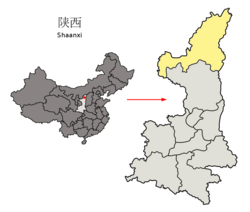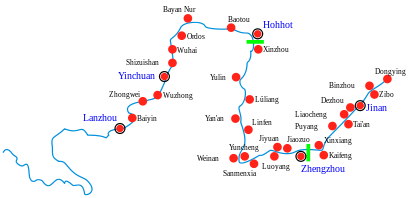Yulin, Shaanxi
Yulin
榆林市 | |
|---|---|
 | |
 Location of Yulin City jurisdiction in Shaanxi | |
| Country | People's Republic of China |
| Province | Shaanxi |
| Municipal seat | Yuyang District |
| Area | |
| • Total | 43,578 km2 (16,826 sq mi) |
| Elevation | 1,084 m (3,556 ft) |
| Population | |
| • Total | 3,380,000 |
| • Density | 78/km2 (200/sq mi) |
| Time zone | UTC+8 (China Standard) |
| Licence plates | 陕K |
| Website | yl |
Yulin (Chinese: 榆林; pinyin: Yúlín) is a prefecture-level city in the Shanbei region of Shaanxi province, China, bordering Inner Mongolia to the north, Shanxi to the east, and Ningxia to the west. It has an administrative area of 43,578 km2 (16,826 sq mi) and a population of 3,380,000.[1]
Geography
Yulin is the northernmost prefecture-level city of Shaanxi, and borders Ordos City (Inner Mongolia) to the north, Xinzhou and Lüliang (Shanxi) to the east, Yan'an to the south, and Wuzhong (Ningxia) to the west. To the north and northwest of the city lies the Ordos Desert, though the countryside is very green due to the many small shrubs which have been planted to slow the process of desertification. The city is based in a valley which extends north-south, which rises to a very large vantage point to the north east, where a spectacular view of the west and northwest is seen.
Lake Hongjiannao
Lake Hongjiannao lies on the border of Yulin and Ordos City, Inner Mongolia (39°06′N, 109°53′E).[2] It is China's largest "desert freshwater lake".[3] The lake is relatively recent, formed around 1929 due to increased rainfall in the early 20th century; before, the basin was a wetland. The lake is supplied by four rivers, but there is no outflow. When its surface area was about 60 km2 (23 sq mi), its maximum depth was 10.5 m (34 ft) and the average depth 8.2 m (27 ft).[2] However, the lake has been shrinking sharply over the past decade, to 32 km2 (12 sq mi) at the present. The shrinking has been attributed to reservoir construction, mining, and agricultural irrigation.[3]
Lake Hongjiannao is an important breeding habitat for relict gull, a species classified as "vulnerable" by the International Union for Conservation of Nature (IUCN). It is estimated that up to 5,000 pairs breed there, making it the largest breeding colony of relict gulls. Shrinking of the lake and changes in water quality are threatening the colony.[4]
Climate
Yulin has a continental, monsoon-influenced semi-arid climate (Köppen BSk), with very cold, rather long winters, and hot and somewhat humid summers. Monthly averages range from −9.4 °C (15.1 °F) to 23.4 °C (74.1 °F) in July, and the annual mean is 8.29 °C (46.9 °F). Spring is especially prone to sandstorms blowing in from the northwest. There is only 366 millimetres (14.4 in) of precipitation annually, 73% of which occurs from June to September. Due to the aridity, diurnal temperature variation is large for most of the year, averaging 13.8 °C (24.8 °F) annually. With monthly percent possible sunshine ranging from 60% in three months to 65% in four months, the city receives 2,780 hours of bright sunshine annually.
| Climate data for Yulin, Shaanxi (1971−2000) | |||||||||||||
|---|---|---|---|---|---|---|---|---|---|---|---|---|---|
| Month | Jan | Feb | Mar | Apr | May | Jun | Jul | Aug | Sep | Oct | Nov | Dec | Year |
| Mean daily maximum °C (°F) | −1.2 (29.8) |
2.8 (37.0) |
9.8 (49.6) |
18.4 (65.1) |
24.4 (75.9) |
28.3 (82.9) |
29.8 (85.6) |
27.8 (82.0) |
22.9 (73.2) |
16.3 (61.3) |
7.8 (46.0) |
0.7 (33.3) |
15.7 (60.2) |
| Mean daily minimum °C (°F) | −15.9 (3.4) |
−11.3 (11.7) |
−3.6 (25.5) |
3.2 (37.8) |
9.3 (48.7) |
14.0 (57.2) |
17.1 (62.8) |
15.9 (60.6) |
9.7 (49.5) |
2.6 (36.7) |
−5.3 (22.5) |
−13 (9) |
1.9 (35.4) |
| Average precipitation mm (inches) | 2.3 (0.09) |
3.8 (0.15) |
11.9 (0.47) |
18.3 (0.72) |
29.2 (1.15) |
42.8 (1.69) |
87.0 (3.43) |
91.2 (3.59) |
47.4 (1.87) |
22.2 (0.87) |
7.8 (0.31) |
1.8 (0.07) |
365.7 (14.41) |
| Average precipitation days (≥ 0.1 mm) | 2.0 | 2.6 | 3.9 | 4.2 | 5.6 | 8.1 | 9.7 | 10.4 | 8.9 | 5.3 | 2.9 | 1.5 | 65.1 |
| Average relative humidity (%) | 55 | 52 | 49 | 42 | 43 | 51 | 62 | 67 | 67 | 63 | 61 | 58 | 56 |
| Mean monthly sunshine hours | 197.8 | 187.7 | 220.3 | 245.0 | 282.4 | 278.8 | 269.5 | 252.1 | 232.5 | 225.7 | 198.5 | 186.5 | 2,776.8 |
| Percent possible sunshine | 65 | 62 | 60 | 62 | 65 | 63 | 60 | 60 | 62 | 65 | 65 | 63 | 63 |
| Source: China Meteorological Administration | |||||||||||||
Transportation
History
Yulin played host to the 11th CHIME (European Foundation for Chinese Music Research) conference in August 2006.
Administration
Yulin consists of two districts, and 10 counties.
| Map | ||||||
|---|---|---|---|---|---|---|
| # | Name | Hanzi | Hanyu Pinyin | Population (2004 est.) | Area (km2) | Density (/km2) |
| 1 | Yuyang District | 榆阳区 | Yúyáng Qū | 460,000 | 7,053 | 65 |
| 4 | Hengshan District | 横山区 | Héngshān Qū | 330,000 | 4,084 | 81 |
| 2 | Shenmu County | 神木县 | Shénmù Xiàn | 370,000 | 7,635 | 48 |
| 3 | Fugu County | 府谷县 | Fǔgǔ Xiàn | 210,000 | 3,212 | 65 |
| 5 | Jingbian County | 靖边县 | Jìngbiān Xiàn | 290,000 | 5,088 | 57 |
| 6 | Dingbian County | 定边县 | Dìngbiān Xiàn | 310,000 | 6,920 | 45 |
| 7 | Suide County | 绥德县 | Suídé Xiàn | 350,000 | 1,878 | 186 |
| 8 | Mizhi County | 米脂县 | Mǐzhī Xiàn | 210,000 | 1,212 | 173 |
| 9 | Jia County | 佳县 | Jiā Xiàn | 250,000 | 2,144 | 117 |
| 10 | Wubu County | 吴堡县 | Wúbǔ Xiàn | 80,000 | 428 | 187 |
| 11 | Qingjian County | 清涧县 | Qīngjiàn Xiàn | 210,000 | 1,881 | 112 |
| 12 | Zizhou County | 子洲县 | Zǐzhōu Xiàn | 310,000 | 2,043 | 152 |
Culture
Because of its relative isolation, a considerable amount of classical architecture remains in the city proper including the original city wall, some of which has been restored. Other cultural relics include the Zhen Bei Tai watchtower, built during the Ming Dynasty, which is the largest troop fortress built on the entire Great Wall, with original and restored pieces of the original Great Wall juxtaposed on both sides. There is a large restoration in process on this area of the Great Wall. In addition, pieces of the ancient Great Wall built during the Qin Dynasty are scattered along the outskirts of town. There is also the Red Stone Gorge, a canyon lined with grottoes containing carved ancient writing and Buddhist art. The town also contains an ancient pagoda.
The Chinese dialect of Jin is spoken in Yulin.
Environment
This section is empty. You can help by adding to it. (January 2015) |
Economy
Although most of the local people live in a very minimal fashion, coal mining provides the predominant source of income. For some, coal mining has brought great riches.
There is a new oil-field project (2005+) just to the west of Yulin which is drilling wells for natural gas, and this has brought a good deal of money into the local economy.
This new oil/gas development is the current largest onshore project cooperated by the PetroChina and International Energy Company (Shell) in Mainland of China since 1999 (Product Sharing Contract(PSC) signed). In 2005, this project progressed to the construction and drilling phase and delivered gas into Shaanxi-Jing No.2 pipeline in 2007. The target annual gas production is 3 billion cubic meters (BCM) after this project reaches its full production capacity.
Notable People
- Li Zicheng (1606-1645), rebel leader that established Shun Dynasty.
References
- ^ Template:Zh icon Profile of Yulin, visited on June 2, 2008.
- ^ a b Shen, J.; Wang, Y.; Yang, X.; Zhang, E.; Yang, B.; Ji, J. (2005). "Paleosandstorm characteristics and lake evolution history deduced from investigation on lacustrine sediments—The case of Hongjiannao Lake, Shaanxi Province". Chinese Science Bulletin. 50 (20): 2355–2361. doi:10.1007/BF03183747.
- ^ a b Yang, Yi (2013-11-28). "China's largest desert freshwater lake shrinking". English.news.cn. Xinhua.
- ^ Template:IUCN2013.1


